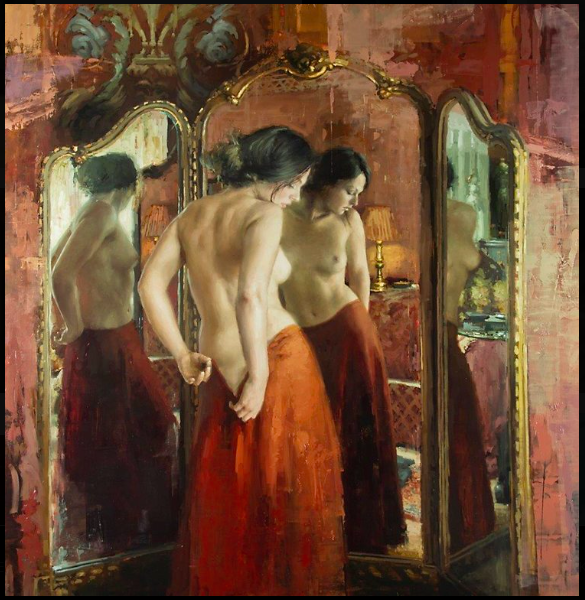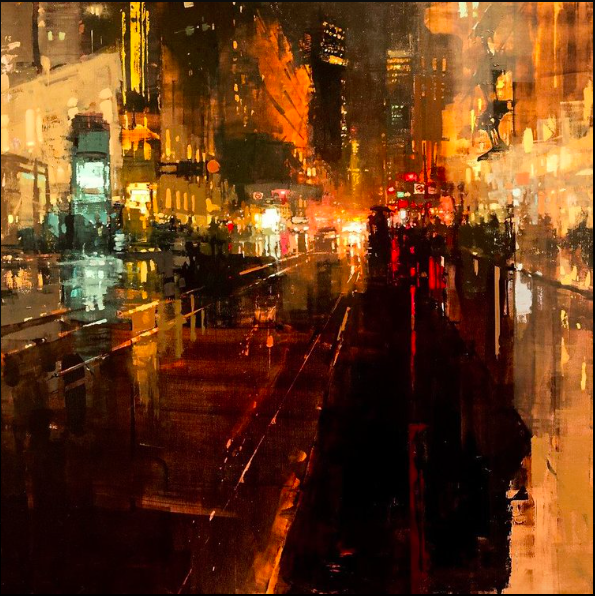The Daily Mail, a British newspaper, did an experiment to determine whether visitors would spend more time looking at British art from the 19th century or works by contemporary British artists.
On average, contemporary abstract art by renowned artists like Rachel Whiteread and Damien Hirst were looked at for five seconds or less, the longest view (of Hirst’s dead sheep suspended in formaldehyde installation) being a few minutes – and that by some school boys.
However 19th century figurative works invited views on average twenty-five times as long. Some for upwards of thirty minutes. These were paintings such as John Millais’ Ophilia and James Whitler’s Nocturne: Blue and Silver – Cremorne Lights.
I’m like those everyday British museum goers – much of contemporary art simply doesn’t appeal to me. It’s often abstract and doesn’t evoke emotion in me (think of Gerhard Richter’s large oil-on-glass monochrome red Mirror, Blood Red). Sometimes it seems nonsensical like the 340 ton boulder, called Levitate Mass installed at the Los Angeles County Museum of Art. Works like this seem to be some sort of intellectual exercise of the artist. And for the regular viewer to appreciate it there has to be prior knowledge of the artist, and the artistic statements they want to make.
However, over the course of this class I started researching whether there were contemporary artists who could evoke emotions, stimulate my interest and keep my eye engaged in their work for more than a few moments. Here are a few I’ve discovered –
 Sergio Roffo is an American coastal landscape painter who immigrated to the United States from Italy in childhood. His stated interest is in color and light’s effect on the natural world. Completed in 2015, At Sunrise is a 30″ x 40″ oil on canvas painting depicting a dory at anchor. My eyes are first drawn to the dory’s ripled reflection in the not quite still sea water. I then find my eyes trying to distinguish between the sea and the horizon. The morning haze, turned pink and rose by the morning sun, obscures the horizon line. The shading from dark green at the bottom of the painting to a pink rose at the top fascinates me and fills me with a sense of tranquility.
Sergio Roffo is an American coastal landscape painter who immigrated to the United States from Italy in childhood. His stated interest is in color and light’s effect on the natural world. Completed in 2015, At Sunrise is a 30″ x 40″ oil on canvas painting depicting a dory at anchor. My eyes are first drawn to the dory’s ripled reflection in the not quite still sea water. I then find my eyes trying to distinguish between the sea and the horizon. The morning haze, turned pink and rose by the morning sun, obscures the horizon line. The shading from dark green at the bottom of the painting to a pink rose at the top fascinates me and fills me with a sense of tranquility.

Odd Nerdrum is a Norwegian painter who considers Rembrandt and Carravagio his primary influence. He mixes his own pigments and stretches canvas to paint on. I find the 1995 painting above, The Bargain, incredibly intriguing. In subject and color it reminds me of 17th and 18th century American paintings depicting Native Americans. The landscape is mysterious and apocalyptic, and the eye is drawn to an couple in mythical primitive garb. There is a light source from the left which focuses the eye on on the man’s shoulder and woman’s breast. He is grasping his cloak and she is grasping her breast. He’s armed with what may be flintlock rifle. What is the bargain? Is it between the and woman? Is it between one people and another?

Mario A. Robinson is an American pastellist, painter born in 1970. His techniques was influenced by Degas, Rebrandt and Vermeer. Many of his subjects are ordinary people found in rural Alabama where he lives. The Baptist is an 22” x 20” pastel completed 2004. Before I knew the title of the painting I thought to myself, “What book would be important enough for a the subject of the painting to hold?”. Now knowing the pastel’s title, I assume it is the Bible. Something about the shades of blue and brown in this I find beautiful. The various shades of brown in the old Bible’s leather cover match those of the man’s skin. My eye moves from the top of the painting and browns of the man’s face, downward to the Bible and end with his hands. They all share various shades of brown, and because they’re centered, I believe they are emphasized and given importance.

Lester is a 15” x 20” graphite drawing completed in 2004 by Robinson. It captures what may be a look of concern on a man’s face as he gazes over his left shoulder. Ranch or farm fencing is hinted at past him and beyond that, a tree line. The more I look at this drawing, the more I see. For instance, his ringlets of his hair look to be plastered to his scalp from sweat and he has a beard. His furrowed brow is shadowed as the light is from above and behind. It’s this point on his face that my eye is drawn too. I’ve looked at this many times and it holds my interest.

Jeremy Mann is a San Francisco painter whose work features Impressionistic cityscapes, figures and landscapes. The one above is a 53’ X 50” oil on panel, titled, Una Bella Adagio (A Beautiful Adagio) completed in 2012. Adagio is a slow musical movement, in this case giving life to the woman’s slow movements in front of the three panel mirror. I love how we can see her back, and a silhouette of her breast, but the mirrors allow us to see three views of her front. Mann wonderfully captures the slow movement of the woman removing her skirt.

Mann’s Another Night Through Storms is a 36” x 30” oil on panel completed in 2015. This is an example of modern Impressionism. No single element of the painting is particularly realistic, and it’s not a photo or hyper-realistic painting. But like Monet and his lilies, I know that this is exactly what a nighttime city street looks like after a rain. I find the yellow, gold and red shadings incredible interesting and my eye lingers on the implied business of the city at night after a rain.
The works I looked at above all communicate something – they are composed of images of things that we see in the world. They can be interpreted and tell a story. It may be mysterious, and not fully understood, but a story is told if even just a single moment from the narrative.
Works Cited
“Contemporary Academic Realism.” Artsy, https://www.artsy.net/gene/contemporary-academic-realism
Dalton, John. “Living Masters – the top realist painters working today.” John Dalton – gently does it. . .”, 4 Jan. 2016, http://www.johndalton.me/living-masters-the-top-realist-painters-working-today/
Hamilton, Martina. “Odd Nerdrum.” Martina Hamilton Fine Art, Inc. http://www.oddnerdrum.com/frame_odd.htm
Henscher, Phillip. “We Know What We Like, and it’s Not Modern Art! How Gallery Visitors only Viewed Work by Damien Hirst and Tracy Emin for Less than 5 Seconds.” Dailymail, 12 March, 2011 http://www.dailymail.co.uk/news/article-1365672/Modern-art-How-gallery-visitors-viewed-work-Damien-Hirst-Tracy-Emin-5-seconds.html
“Mario A. Robinson.” ARC, http://www.artrenewal.org/pages/artist.php?artistid=3323
“Odd Nerdrum.” Wikipedia, 12 Nov. 2016, https://en.wikipedia.org/wiki/Odd_Nerdrum
Ross, Frederick. “Why Realism?.” ARC, 7 Feb. 2014, http://www.artrenewal.org/articles/Philosophy/Why_Realism/why_realism.php

I enjoyed the pieces of artwork you had chosen to showcase in your blog. I agree with your statement about contemporary art, as it does not appeal to me as well. I appreciated your analysis of the painting “At Sunrise”, as the shading of the colors used in the paintings had fascinated me as well. I particularly puzzled by “The Bargain”, when exploring the painting it is as if you are apart of the scene, yet there is still mystery lurking within the painting. After viewing “The Bargain” I had decided to look at Odd Nerdrum’s museum page, here is the link: http://nerdrummuseum.com/paintings/
LikeLike